
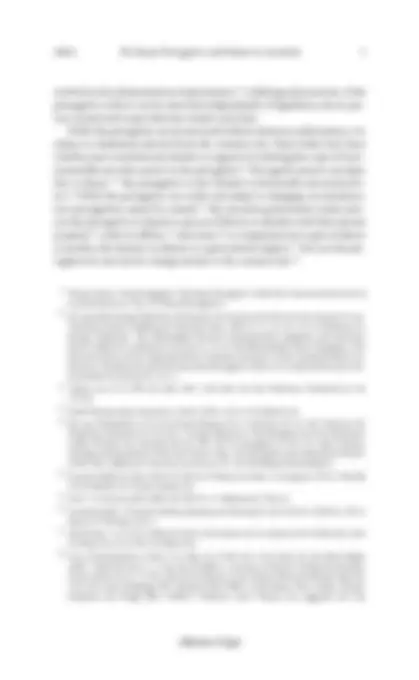
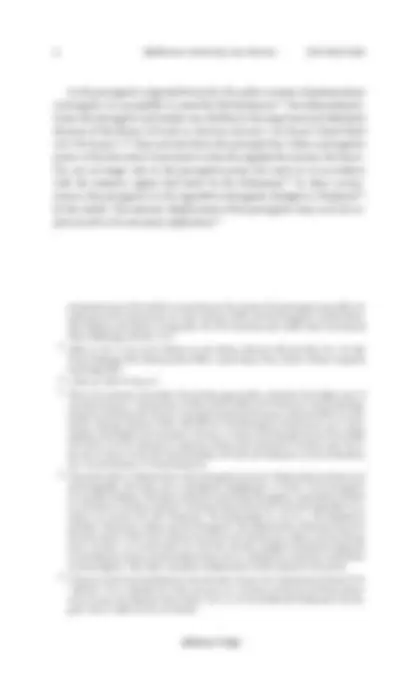
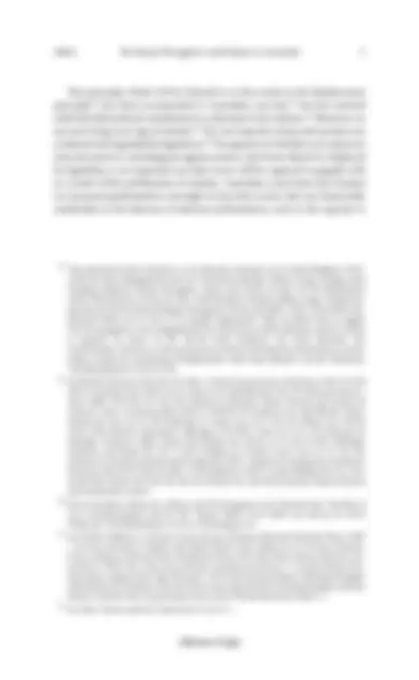
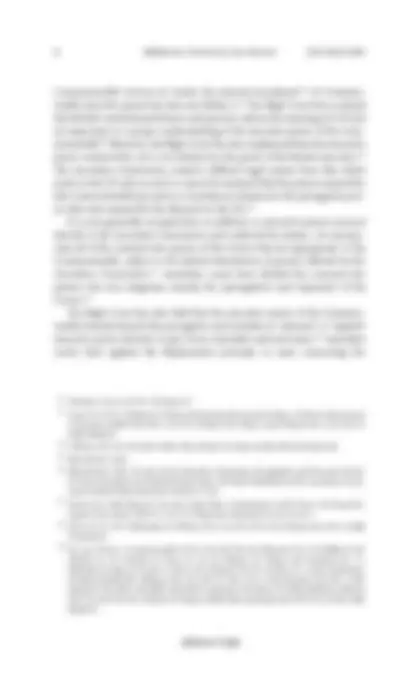
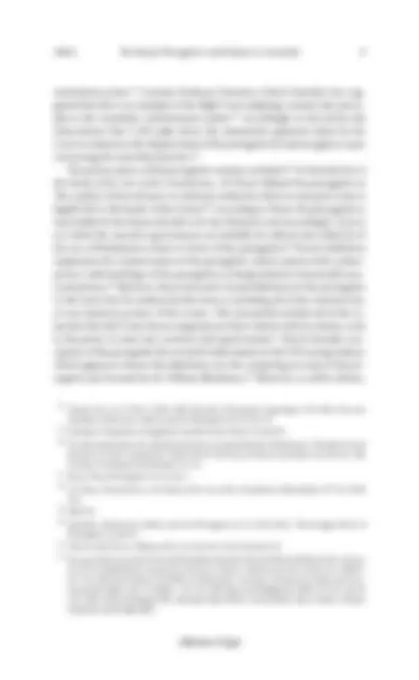
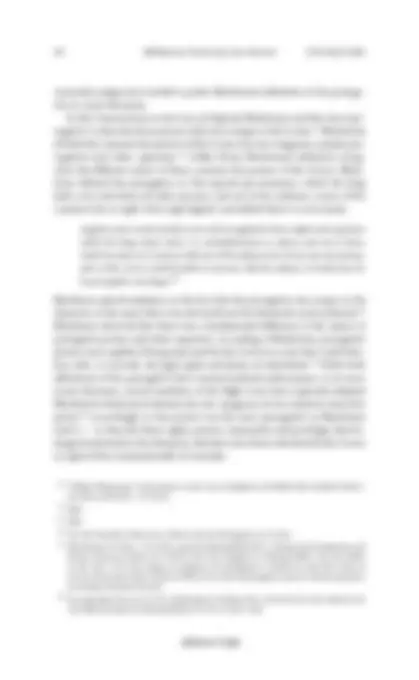
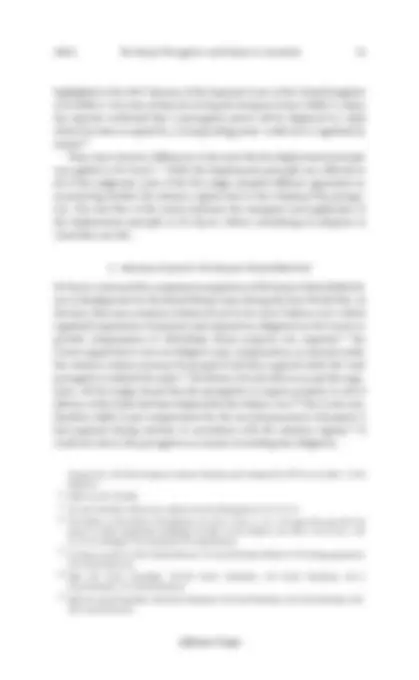
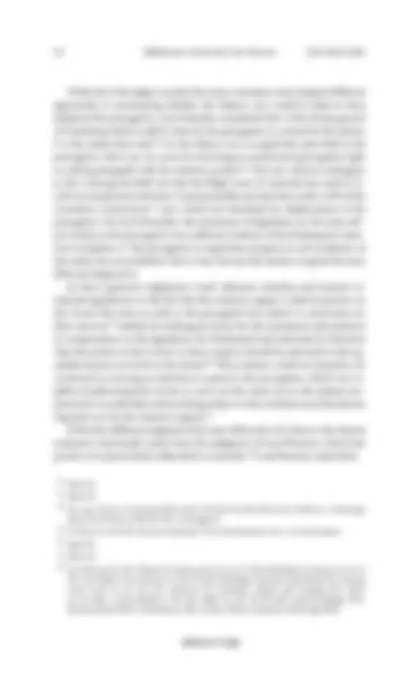
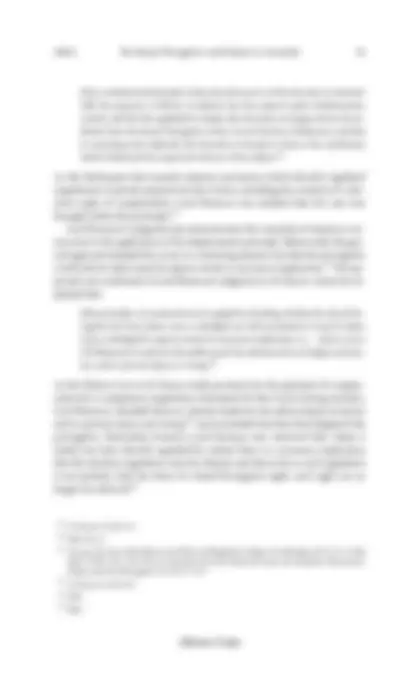
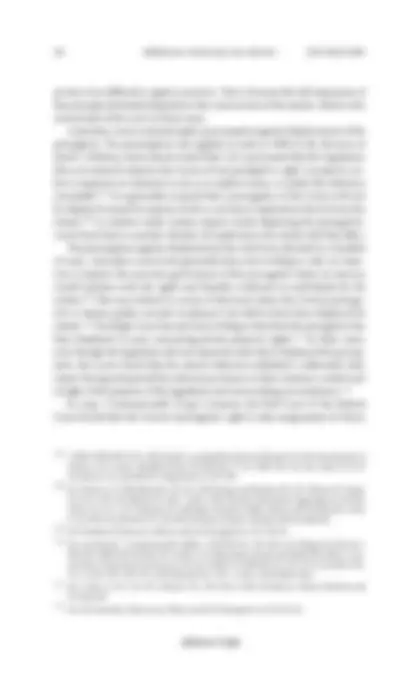
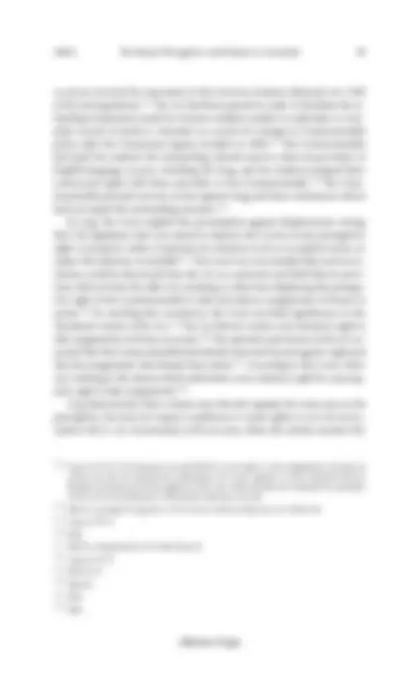
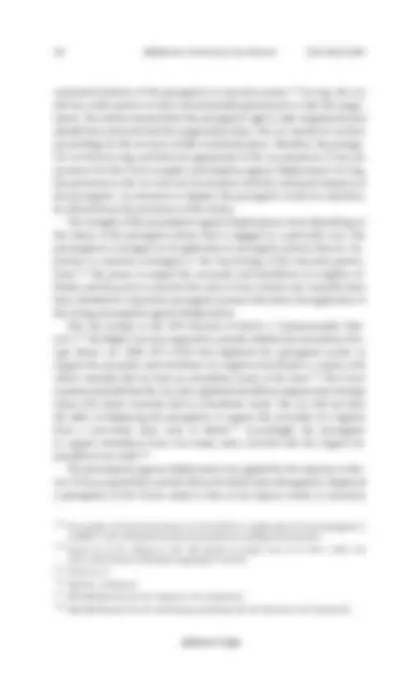
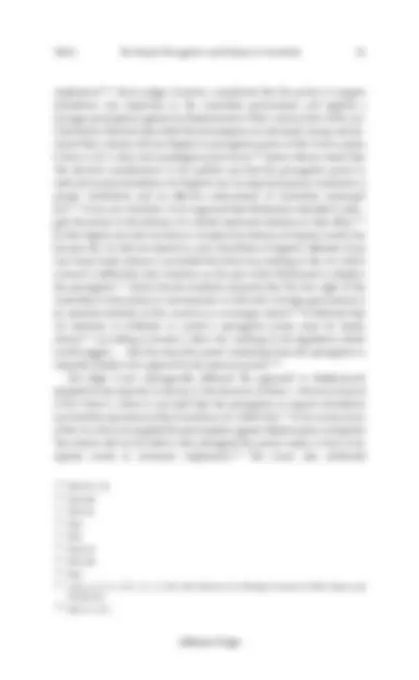
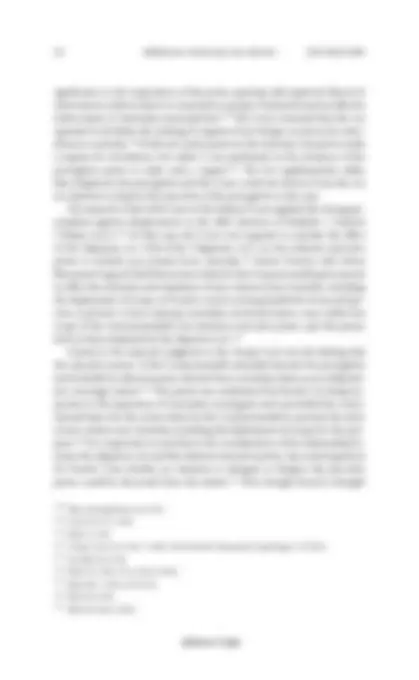
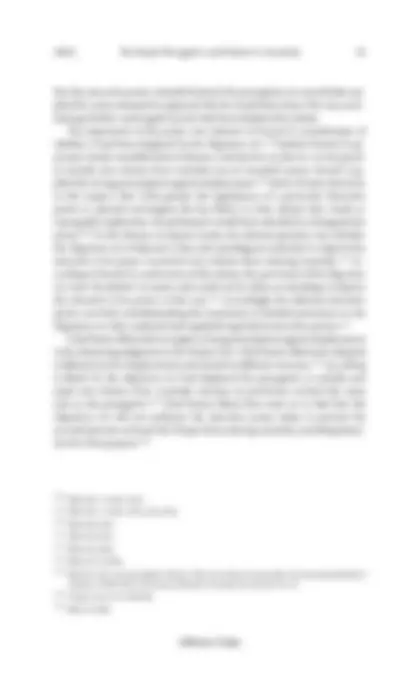
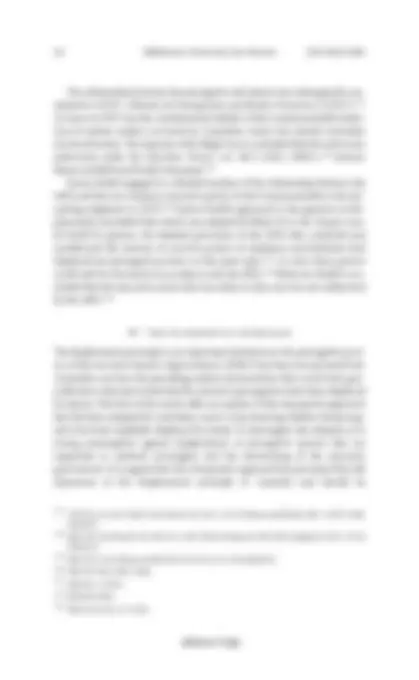
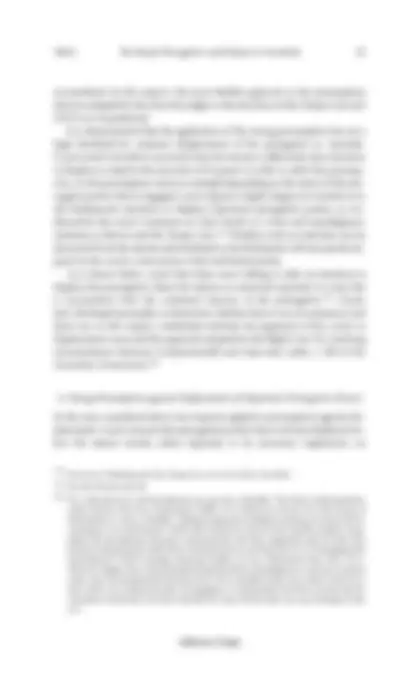
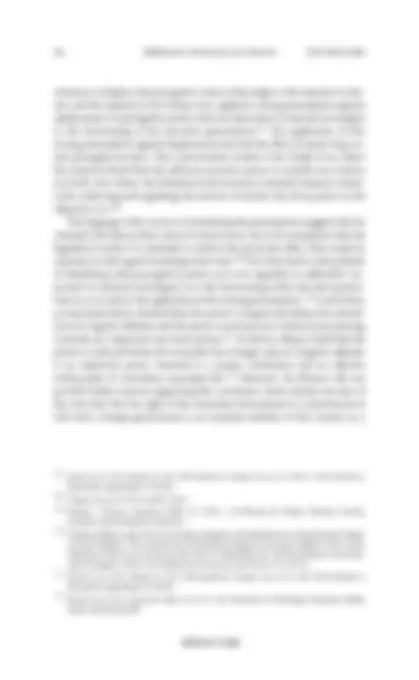
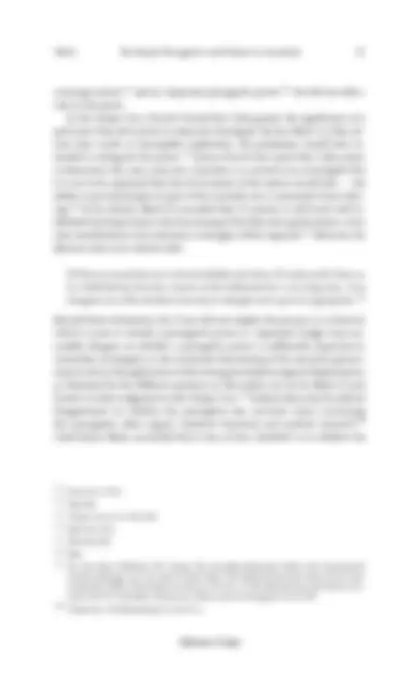
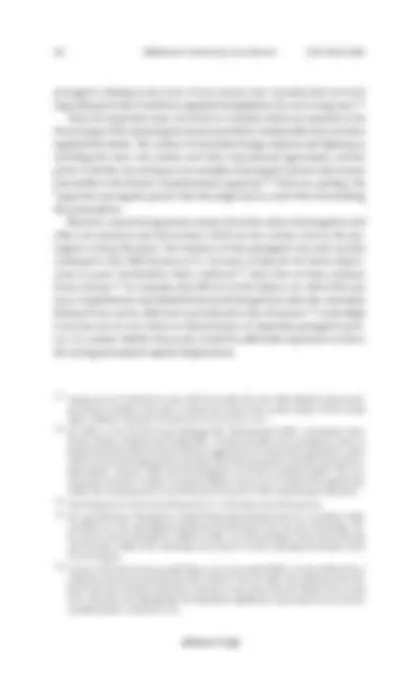
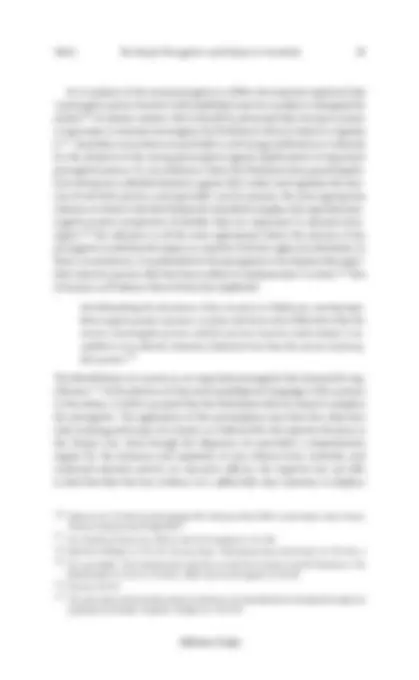
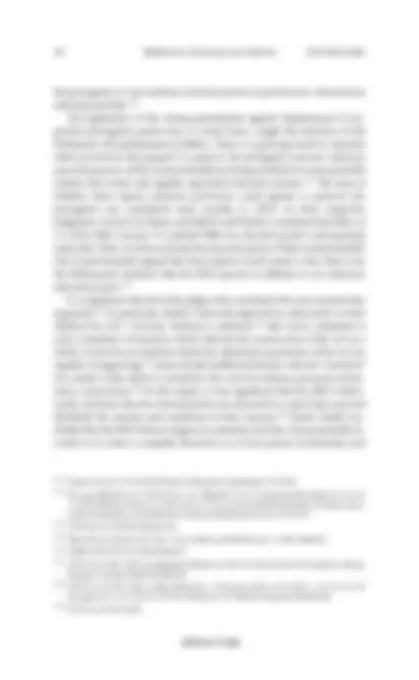
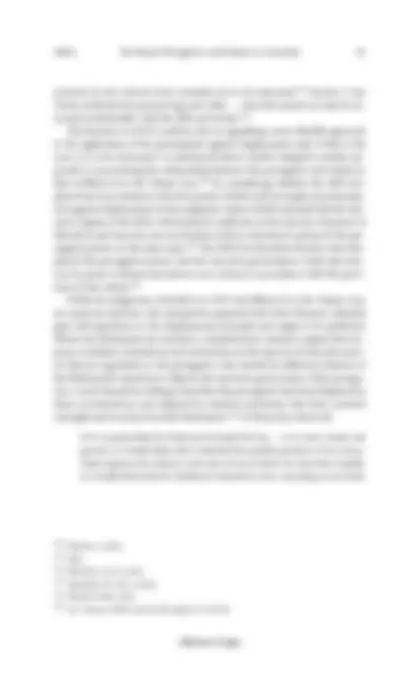
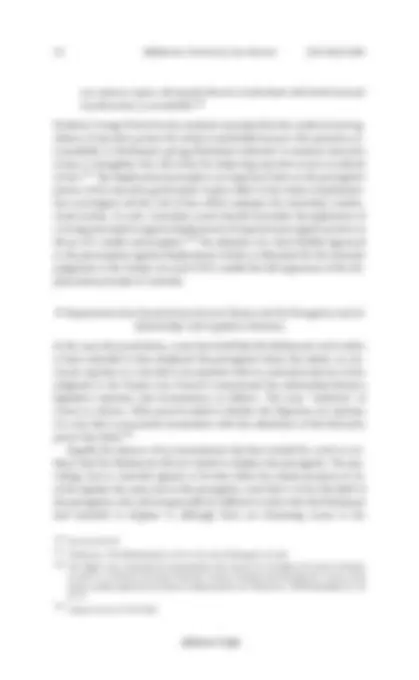
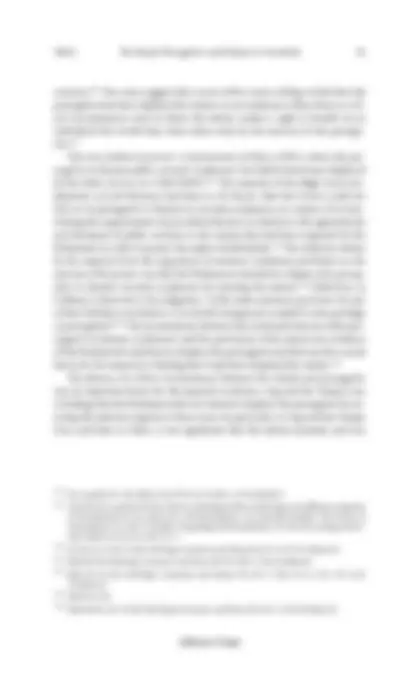
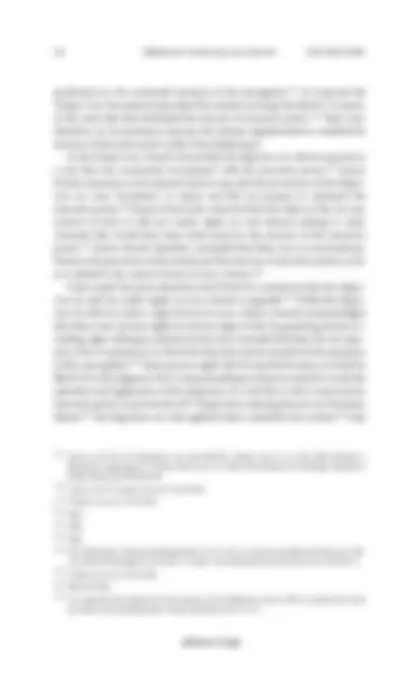
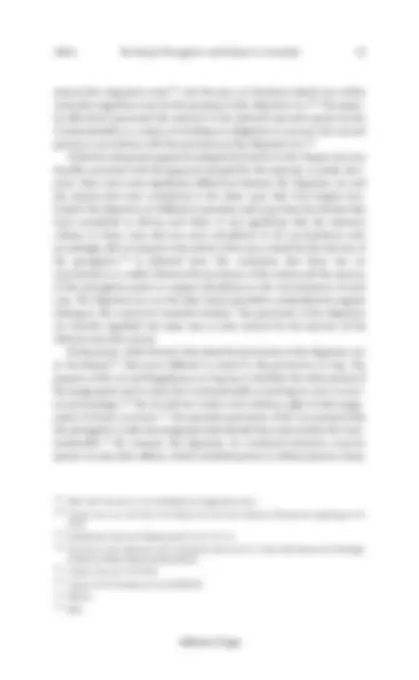
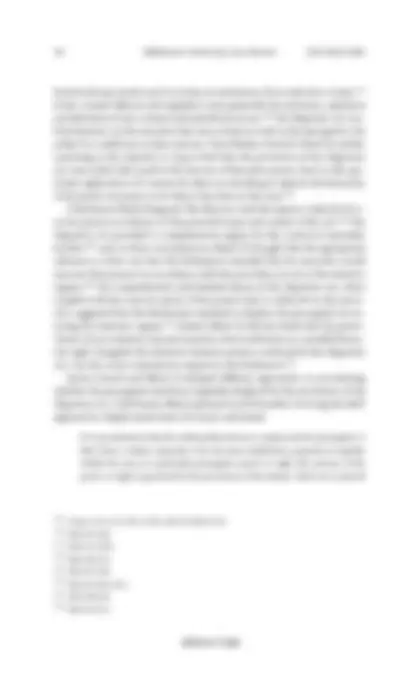
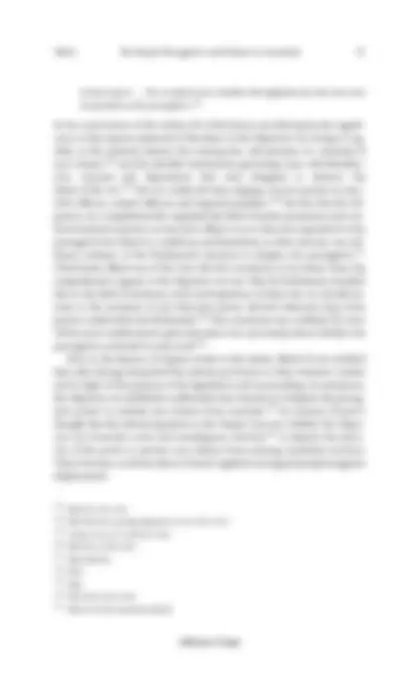
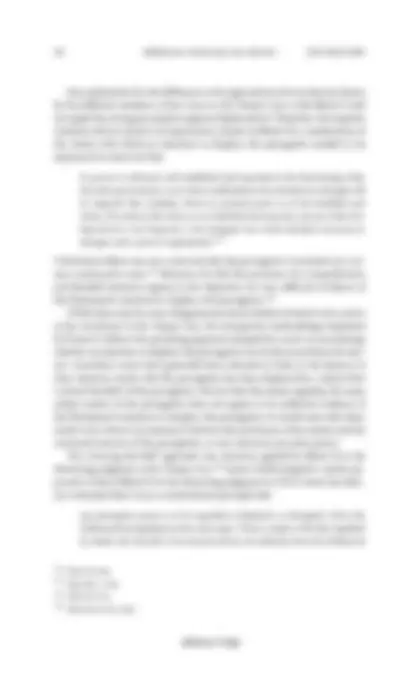
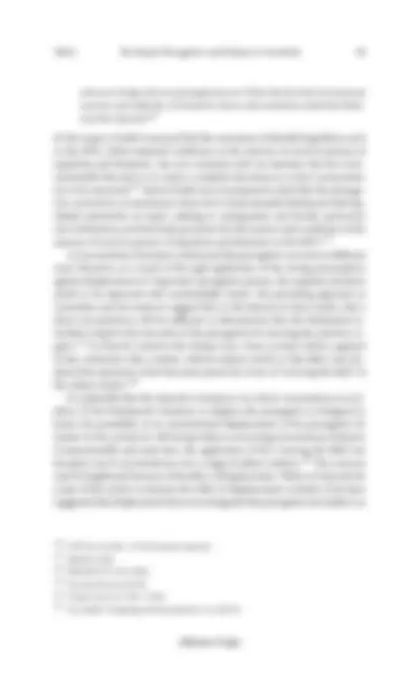
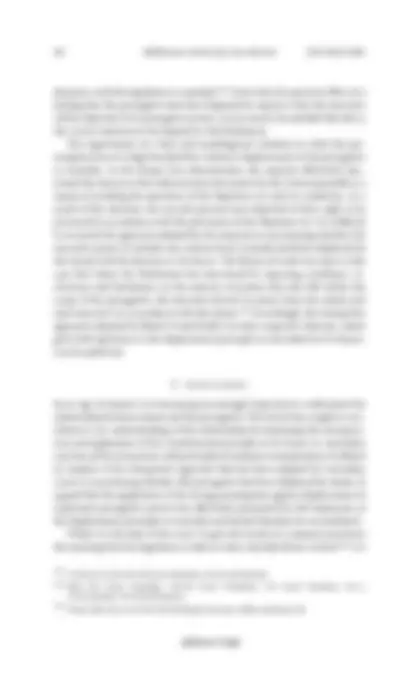
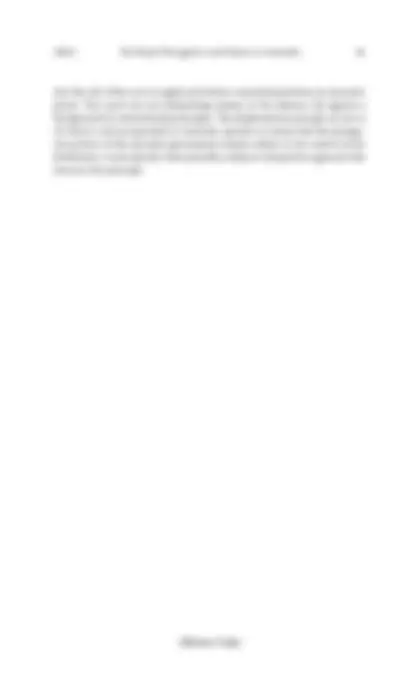


Study with the several resources on Docsity

Earn points by helping other students or get them with a premium plan


Prepare for your exams
Study with the several resources on Docsity

Earn points to download
Earn points by helping other students or get them with a premium plan
Community
Ask the community for help and clear up your study doubts
Discover the best universities in your country according to Docsity users
Free resources
Download our free guides on studying techniques, anxiety management strategies, and thesis advice from Docsity tutors
The 'displacement principle' in Australian law, which determines whether non-statutory executive powers, including prerogative powers, have been altered or displaced by legislation. The article focuses on the application of this principle in the context of the Royal Prerogative and its impact on the control of entry of non-citizens into Australia. The document also explores the implications of this principle for parliamentary drafters and the role of the courts in interpreting statutes.
What you will learn
Typology: Lecture notes
1 / 41

This page cannot be seen from the preview
Don't miss anything!


































Cite as Peta Stephenson, ‘e Relationship between the Royal Prerogative and Statute in Australia’ (2021) 44(3)Melbourne University Law Review (advance)
2 Melbourne University Law Review [Vol 44(3):Adv
I I N T R O D U C T I O N
e royal prerogative remains an important source of authority for government
action in Australia. e power to declare war and peace,^1 enter into treaties
with foreign governments,^2 request the surrender and extradition of fugitives
from foreign states,^3 call out the military to maintain the peace,^4 and exclude
non-citizens from Australia^5 are all executive acts that are understood as falling
within the prerogative. In his Honour’s tripartite classification of prerogative
powers in Federal Commissioner of Taxation v Official Liquidator of E O Farley
Ltd (in liq) (‘Farley’s Case’), Evatt J referred to these powers as the ‘executive
prerogatives’ that were generally vested exclusively in the Crown in right of the
Commonwealth of Australia.^6 Today, these prerogative powers are exercised by
Commonwealth ministers or the Governor-General, who almost always acts
on ministerial advice.^7
e term ‘prerogative’ refers collectively to the bundle of discretionary
rights, powers, privileges and immunities that were enjoyed exclusively by the
Monarch in the United Kingdom (‘UK’). e prerogative has been described
as ‘a relic of a past age’,^8 le over from a time when the Monarch was directly
(^1) Farey v Burvett (1916) 21 CLR 433, 452 (Isaacs J) (‘Farey’). (^2) R v Burgess; Ex parte Henry (1936) 55 CLR 608, 635–6 (Latham CJ), 681 (Evatt and McTiernan JJ) (‘Burgess’); Koowarta v Bjelke-Petersen (1982) 153 CLR 168, 193 (Gibbs CJ). (^3) Barton v Commonwealth (1974) 131 CLR 477, 485 (Barwick CJ), 498–9 (Mason J), 505– (Jacobs J) (‘Barton’); Oates v A-G (Cth) (2003) 214 CLR 496, 511 [37] (Gleeson CJ, McHugh, Gummow, Kirby, Hayne and Heydon JJ) (‘Oates’). (^4) See R v Secretary of State for the Home Department; Ex parte Northumbria Police Authority [1989] 1 QB 26, 44 (Croom-Johnson LJ), 45–6 (Purchas LJ), 58–9 (Nourse LJ) (‘Northumbria’). In Australia, the exercise of this power would be subject to s 119 of the Australian Constitution. It is unclear whether, and to what extent, this prerogative has survived the enactment of pt IIIAAA of the Defence Act 1903 (Cth) (‘Commonwealth Defence Act’), which sets out a com- prehensive regime for the deployment of the Australian Defence Force when it is called out to protect the states against domestic violence or to protect Commonwealth interests. is ques- tion has not yet received judicial consideration. (^5) See Ruddock v Vadarlis (2001) 110 FCR 491, 495–501 [9]–[29] (Black CJ) (‘Tampa Case’). (^6) (1940) 63 CLR 278, 320–1 (‘Farley’s Case’). e prerogative powers of the Crown also include legal preferences, immunities and exceptions which were denied to its subjects and certain proprietary rights: at 321. (^7) e Governor-General is generally not required to act on advice in the exercise of ‘reserve powers’, which resemble the personal prerogatives of the Monarch. e exercise of reserve powers is guided by the conventions of responsible government: see Anne Twomey, e Veiled Sceptre: Reserve Powers of Heads of State in Westminster Systems (Cambridge University Press,
4 Melbourne University Law Review [Vol 44(3):Adv
As the prerogative originated from the UK under a system of parliamentary
sovereignty, it is susceptible to control by the Parliament.^19 e relationship be-
tween the prerogative and statute was clarified in the important and influential
decision of the House of Lords in Attorney-General v De Keyser’s Royal Hotel
Ltd (‘De Keyser’).^20 at case laid down the principle that ‘when a prerogative
power of the Executive Government is directly regulated by statute, the Execu-
tive can no longer rely on the prerogative power but must act in accordance
with the statutory regime laid down by the Parliament’.^21 In these circum-
stances, the prerogative is to be regarded as abrogated, abridged or ‘displaced’^22
by the statute. e statutory displacement of the prerogative may occur by ex-
press words or by necessary implication.^23
proposition may not be entirely accurate because the exercise of the prerogative may affect the application of the common law: see Anne Twomey, ‘Miller and the Prerogative’ in Mark Elliott, Jack Williams and Alison L Young (eds), e UK Constitution aer Miller: Brexit and Beyond (Hart Publishing, 2018) 69, 73–6. (^19) Miller (n 18 ) 75 [25] (Lord omas CJ, Sir Terence Etherton MR and Sales LJ), 139 [48] (Lord Neuberger PSC, Baroness Hale DPSC, Lords Mance, Kerr, Clarke, Wilson, Sumption and Hodge JJSC). (^20) [1920] AC 508 (‘De Keyser’). (^21) is is the statement of principle that has been approved by a plurality of the High Court of Australia in Jarratt v Commissioner of Police (NSW) (2005) 224 CLR 44, 69–70 [85] (McHugh, Gummow and Hayne JJ) (‘Jarratt’), quoting Re Residential Tenancies Tribunal (NSW); Ex parte Defence Housing Authority (1997) 190 CLR 410, 459 (McHugh J) (‘Henderson’s Case’), and a majority of the High Court in Northern Territory v Arnhem Land Aboriginal Land Trust (2008) 236 CLR 24, 58 [27] (Gleeson CJ, Gummow, Hayne and Crennan JJ) (‘Arnhem Land Trust’). See also De Keyser (n 20 ) 526 (Lord Dunedin), 539–40 (Lord Atkinson), 554 (Lord Moulton), 561–2 (Lord Sumner), 575 (Lord Parmoor). (^22) is article refers to ‘displacement’ of the prerogative by statute. ‘Displacement’ has been used interchangeably with terms such as ‘abrogation’, ‘abridgement’ or ‘ouster’ of the prerogative: see, eg, John Goldring, ‘e Impact of Statutes on the Royal Prerogative: Australasian Attitudes as to the Rule in Attorney-General v De Keyser’s Royal Hotel Ltd’ (1974) 48 (September) Aus- tralian Law Journal 434, 438; Winterton, ‘e Relationship’ (n 10 ) 43 n 150; Benjamin B Saunders, ‘Democracy, Liberty and the Prerogative: e Displacement of Inherent Executive Power by Statute’ (2013) 41(2) Federal Law Review 363 (‘Democracy, Liberty and the Prerog- ative’). In Oates v A-G (Cth) (2001) 181 ALR 559, 569 [40], Lindgren J interpreted ‘displaced’ as ‘including the notion of partial displacement, that is, confinement, restriction or limitation’ of the prerogative. is wider conception of displacement will be adopted in this article. (^23) De Keyser (n 20 ) 576 (Lord Parmoor). See also Laker Airways Ltd v Department of Trade [1977] 1 QB 643, 719–21 (Roskill LJ) (‘Laker Airways’); R v Secretary of State for the Home Depart- ment; Ex parte Fire Brigades Union [1995] 2 AC 513, 552 (Lord Browne-Wilkinson) (‘Fire Bri- gades Union’); Miller (n 18 ) 139–40 [48].
2021] e Royal Prerogative and Statute in Australia 5
is principle, which will be referred to in this article as the ‘displacement
principle’,^24 has been incorporated in Australian case law,^25 but has received
relatively little judicial consideration or attention from scholars.^26 However, we
are now living in an ‘age of statutes’.^27 e vast majority of executive powers are
conferred and regulated by legislation.^28 e question of whether non-statutory
executive powers, including prerogative powers, have been altered or displaced
by legislation is an important one that courts will be required to grapple with
as a result of this proliferation of statutes. Australian courts have also insisted
on increased parliamentary oversight of executive action that was historically
undertaken in the absence of statutory authorisation, such as the capacity to
(^24) is principle has been referred to as the ‘abeyance principle’ in the United Kingdom (‘UK’), which has been distinguished from the ‘frustration principle’: Robert Craig, ‘Casting Aside Clanking Medieval Chains: Prerogative, Statute and Article 50 aer the EU Referendum’ (2016) 79(6) Modern Law Review 1041, 1046 (‘Medieval Chains’); Robert Craig, ‘A Simple Ap- plication of the Frustration Principle: Prerogative, Statute and Miller’ [2017] (November Sup- plement) Public Law 25, 28–9, 33 (‘A Simple Application’). ere are obiter dicta to suggest that the prerogative is not extinguished by the statute but is held in abeyance until the statute is repealed: De Keyser (n 20 ) 539–40 (Lord Atkinson), 554 (Lord Moulton), 562 (Lord Sumner). However, as this question has not been authoritatively determined, it is pref- erable to adopt the terminology of ‘displacement’ rather than ‘abeyance’: see also Winterton, ‘e Relationship’ (n 10 ) 43 n 150. (^25) Re Richard Foreman & Sons Pty Ltd; Uther v Federal Commissioner of Taxation (1947) 74 CLR 508, 514 (Latham CJ) (‘Uther’s Case’); Barton (n 3 ) 488 (Barwick CJ), 501 (Mason J); Brown v West (1990) 169 CLR 195, 202, 205 (Mason CJ, Brennan, Deane, Dawson and Toohey JJ) (‘Brown’); Ling v Commonwealth (1994) 51 FCR 88, 92 (Gummow, Lee and Hill JJ) (‘Ling’); Henderson’s Case (n 21 ) 459 (McHugh J); Tampa Case (n 5 ) 501 [33] (Black CJ), 539– [181]–[182] (French J, Beaumont J agreeing at 514 [95]); Oates (n 3 ) 511 [37] (Gleeson CJ, McHugh, Gummow, Kirby, Hayne and Heydon JJ); Jarratt (n 21 ) 69–70 [85] (McHugh, Gummow and Hayne JJ), 84–5 [129] (Callinan J); Arnhem Land Trust (n 21 ) 58 [27] (Gleeson CJ, Gummow, Hayne and Crennan JJ); CPCF v Minister for Immigration and Border Protection (2015) 255 CLR 514, 600–1 [279] (Kiefel J) (‘CPCF’); Cadia Holdings Pty Ltd v New South Wales (2010) 242 CLR 195, 204 [14] (French CJ), 228 [94] (Gummow, Hayne, Heydon and Crennan JJ) (‘Cadia’). (^26) But see Saunders, Democracy, Liberty and the Prerogative (n 22 ); Simon Evans, ‘e Rule of Law, Constitutionalism and the MV Tampa’ (2002) 13(2) Public Law Review 94, 98–9; Winterton, ‘e Relationship’ (n 10 ) 42–9; Goldring (n 22 ). (^27) See Guido Calabresi, A Common Law for the Age of Statutes (Harvard University Press, 1982)
2021] e Royal Prerogative and Statute in Australia 7
displaced the prerogative requires a careful analysis of the meaning, operation
and scope of the statute. e outcomes of these cases will, to a large extent,
turn on the provisions of the particular statute and the circumstances of the
individual case.^35 Nevertheless, it is possible to extract broader statements
of principle from the case law that have guided the courts’ approach to
displacement in Australia.
is article offers an analysis of the interpretive approach that has been
adopted by Australian courts in ascertaining whether the prerogative has been
displaced by statute. It interrogates a core feature of this approach, namely, the
adoption of a strong presumption against displacement of prerogative powers
that are important to national sovereignty and the functioning of the executive
government. It is argued that the application of this presumption has prevented
the full expression of the displacement principle in Australia and should be re-
considered. is article proceeds as follows. Part II provides an overview of the
royal prerogative and its incorporation as an aspect of the executive power of
the Commonwealth in s 61 of the Australian Constitution. Part III examines the
emergence of the displacement principle in De Keyser before examining its ap-
plication in Australian case law. Part IV of the article critically examines the
interpretive approach that has been adopted by Australian courts in ascertain-
ing whether the prerogative has been displaced by statute.
I I T H E R OYA L P R E R O G AT I V E
As the subject of this article is statutory displacement of the prerogative, it is
helpful to begin by providing a brief overview of the royal prerogative and its
relationship with the executive power of the Commonwealth in s 61 of the Aus-
tralian Constitution. It is necessary to have an understanding of the prerogative
because, in evaluating whether it has been displaced by statute, courts must
identify the prerogative that is engaged in any particular case. As will be shown,
this is not always a straightforward task because the precise content and scope
of the prerogative are uncertain.
Section 61 is the principal provision dealing with the executive power of the
Commonwealth in the Australian Constitution. Section 61 is situated in ch II of
the Australian Constitution, which is entitled ‘e Executive Government’. Sec-
tion 61 vests the executive power of the Commonwealth in the Queen and
states that it is exercisable by the Governor-General and ‘extends to the execu-
tion and maintenance of this Constitution, and of the laws of the
(^35) See also Saunders, Democracy, Liberty and the Prerogative (n 22 ) 390; BS Markesinis, ‘e Royal Prerogative Re-Visited’ (1973) 32(2) Cambridge Law Journal 287, 305.
8 Melbourne University Law Review [Vol 44(3):Adv
Commonwealth’. Section 61 ‘marks the external boundaries’^36 of Common-
wealth executive power but does not define it.^37 e High Court has accepted
that British constitutional history and practice inform the meaning of s 61 and
are important to ‘a proper understanding of the executive power of the Com-
monwealth’.^38 However, the High Court has also emphasised that the executive
power conferred by s 61 is not identical to the power of the British executive.^39
e Australian Constitution created a different legal system from that which
exists in the UK and, as such, it cannot be assumed that the powers enjoyed by
the Commonwealth executive in Australia are identical to the prerogative pow-
ers that were enjoyed by the Monarch in the UK.^40
It is now generally accepted that, in addition to executive powers sourced
directly in the Australian Constitution and conferred by statute, s 61 incorpo-
rates all of the common law powers of the Crown that are ‘appropriate’ to the
Commonwealth, subject to the federal distribution of powers effected by the
Australian Constitution.^41 Australian courts have divided the common law
powers into two categories, namely, the ‘prerogatives’ and ‘capacities’ of the
Crown.^42
e High Court has also held that the executive power of the Common-
wealth extends beyond the prerogative and includes an ‘inherent’ or ‘implied’
executive power derived, in part, from Australia’s national status.^43 Australian
courts have applied the displacement principle in cases concerning the
(^36) Wooltops Case (n 16 ) 437–40 (Isaacs J). (^37) Davis (n 15 ) 92–3 (Mason CJ, Deane and Gaudron JJ), quoted in Pape v Federal Commissioner of Taxation (2009) 238 CLR 1, 62 [131] (French CJ) (‘Pape’) and Williams [No 1] (n 29 ) 372 [588] (Kiefel J). (^38) Williams [No 2] (n 29 ) 468–9 [80]–[83] (French CJ, Hayne, Kiefel, Bell and Keane JJ). (^39) Ibid 469 [81]–[82]. (^40) Ibid 469 [81]–[83]. See also Cheryl Saunders, ‘Separation of Legislative and Executive Power’ in Cheryl Saunders and Adrienne Stone (eds), e Oxford Handbook of the Australian Consti- tution (Oxford University Press, 2018) 617, 632. (^41) Barton (n 3 ) 498 (Mason J). See also Leslie Zines, ‘Commentary’ in HV Evatt, e Royal Pre- rogative (Law Book, 1987) C1, C4–C5; Winterton, Parliament (n 10 ) 24, 50–1. (^42) Davis (n 15 ) 107–9 (Brennan J); Williams [No 1] (n 29 ) 185–6 [25] (French CJ), 343–4 [488] (Crennan J). (^43) See, eg, Victoria v Commonwealth (1975) 134 CLR 338, 362 (Barwick CJ), 375 (Gibbs J), 397 (Mason J), 412 (Jacobs J); Davis (n 15 ) 94 (Mason CJ, Deane and Gaudron JJ), 111 (Brennan J); Pape (n 37 ) 60–3 [128]–[132] (French CJ), 87–8 [228], 91–2 [242] (Gummow, Crennan and Bell JJ); Williams [No 1] (n 29 ) 191 [34], 216–17 [83] (French CJ), 250–1 [196] (Hayne J), 342 [485], 346 [498], 348 [503] (Crennan J), 370 [583], 373 [594] (Kiefel J); Williams [No 2] (n 29 ) 454 [23] (French CJ, Hayne, Kiefel, Bell and Keane JJ); CPCF (n 25 ) 596 [260] (Kiefel J).
10 Melbourne University Law Review [Vol 44(3):Adv
Australian judges have tended to prefer Blackstone’s definition of the preroga-
tive in recent decisions.
In the Commentaries on the Laws of England, Blackstone used the term ‘pre-
rogative’ to describe those powers that were unique to the Crown.^53 Blackstone
divided the common law powers of the Crown into two categories, namely, pre-
rogatives and other capacities.^54 Unlike Dicey, Blackstone’s definition recog-
nises the different nature of these common law powers of the Crown. Black-
stone defined the prerogative as ‘that special pre-eminence, which the king
hath, over and above all other persons, and out of the ordinary course of the
common law, in right of his regal dignity’ and added that it is in its nature
Blackstone placed emphasis on the fact that the prerogative was unique to the
Monarch, in the sense that it was derived from the Monarch’s royal authority.^56
Blackstone observed that there was a fundamental difference in the nature of
prerogative powers and other capacities. According to Blackstone, prerogative
powers were capable of being exercised by the Crown in a way that could inter-
fere with, or override, the legal rights and duties of individuals.^57 While both
definitions of the prerogative have received judicial endorsement, in its more
recent decisions, several members of the High Court have expressly adopted
Blackstone’s distinction between the two categories of non-statutory executive
power.^58 Accordingly, in this article I use the term ‘prerogative’ as Blackstone
used it — to describe those rights, powers, immunities and privileges that be-
longed exclusively to the Monarch, that have since been inherited by the Crown
in right of the Commonwealth of Australia.
(^53) William Blackstone, Commentaries on the Laws of England, ed Wilfrid Prest (Oxford Univer- sity Press, 2016) bk 1, 155 [232]. (^54) Ibid. (^55) Ibid. (^56) See also Saunders, Democracy, Liberty and the Prerogative (n 22 ) 365. (^57) Blackstone (n 53 ) bk 1, 155 [232], quoted in Plaintiff M68/2015 v Minister for Immigration and Border Protection (2016) 257 CLR 42, 98 [135] (Gageler J) (‘Plaintiff M68’). See also Miller (n 18 ) 140–1 [52]–[53] citing, as examples, the prerogative to decide on, and alter, terms of service of servants of the Crown: GCHQ (n 52 ), and the prerogative power to destroy property in wartime: Burmah Oil (n 8 ). (^58) See especially Davis (n 15 ) 107–9 (Brennan J); Williams [No 1] (n 29 ) 185–6 [25] (French CJ), 344 [488] (Crennan J); Plaintiff M68 (n 57 ) 97–9 [132]–[136].
2021] e Royal Prerogative and Statute in Australia 11
In his judgment in Farley’s Case, Evatt J suggested that the prerogative can
be classified as falling within three categories.^59 Pursuant to its ‘executive pre-
rogatives’, the Commonwealth could perform certain acts, such as declare war
and peace, negotiate and enter into treaties, appoint ambassadors, confer hon-
ours, coin money, acquire territory and grant pardons.^60 By virtue of its ‘com-
mon law prerogatives’, the Crown was entitled to the benefit of legal prefer-
ences, immunities and exceptions which were denied to its subjects. is in-
cluded priority in payment of debts and immunity from court processes.^61 e
third category of prerogative enjoyed by the Crown included proprietary rights
in relation to royal metals, ‘treasure trove’, and the foreshore, seabed and subsoil
within territorial limits.^62
While it was accepted that s 61 incorporated the prerogative, it was le
unclear how the prerogative powers, rights, privileges and immunities would
be distributed between the Commonwealth and state executives.^63 e prerog-
ative needed to be adapted to the Australian federal constitutional context,
which differed from that of the UK as a unitary state. Justice Evatt argued that
the division of the executive prerogatives broadly followed the federal distribu-
tion of legislative powers in ss 51–2 and 122 of the Australian Constitution.^64
Accordingly, most of the executive prerogatives were transferred to, and exer-
cised exclusively by, the Commonwealth. As Australia acquired independence,
these included the prerogative powers of the Imperial government,^65 relating
to foreign affairs and treaties,^66 extradition^67 and war.^68 e preferences and
immunities of the Crown, on the other hand, were shared by both the
(^59) Farley’s Case (n 6 ) 320–1. is classification was first presented in HV Evatt’s doctoral thesis, which was subsequently published in HV Evatt, e Royal Prerogative (Law Book, 1987) 30–1. (^60) See Farley’s Case (n 6 ) 320–1; Evatt (n 59 ) 30–1. (^61) Farley’s Case (n 6 ) 321. (^62) Ibid. (^63) Ibid. See also Cadia (n 25 ) 226 [87] (Gummow, Hayne, Heydon and Crennan JJ). (^64) Farley’s Case (n 6 ) 321–2. (^65) Leslie Zines, ‘e Growth of Australian Nationhood and Its Effect on the Powers of the Com- monwealth’ in Leslie Zines (ed), Commentaries on the Australian Constitution: A Tribute to Geoffrey Sawer (Butterworths, 1977) 1, 6–10; Zines, ‘Commentary’ (n 41 ) C10–C17. (^66) Burgess (n 2 ) 643–4 (Latham CJ), affd Barton (n 3 ) 498 (Mason J). See also New South Wales v Commonwealth (1975) 135 CLR 337, 379, 381 (McTiernan J), 503 (Murphy J) (‘Seas and Sub- merged Lands Case’). (^67) Barton (n 3 ) 485, 488 (Barwick CJ), 490–1 (McTiernan and Menzies JJ), 498–9 (Mason J), 505 (Jacobs J). (^68) Farey (n 1 ) 452 (Isaacs J).
2021] e Royal Prerogative and Statute in Australia 13
highlighted in the 2017 decision of the Supreme Court of the United Kingdom
in R (Miller) v Secretary of State for Exiting the European Union (‘Miller’), where
the majority confirmed that ‘a prerogative power will be displaced in a field
which becomes occupied by a corresponding power conferred or regulated by
statute’.^76
ere were, however, differences in the ways that the displacement principle
was applied in De Keyser.^77 While the displacement principle was reflected in
all of the judgments, each of the five judges adopted different approaches in
ascertaining whether the statutory regime had, in fact, displaced the preroga-
tive. e next Part of the article examines the emergence and application of
the displacement principle in De Keyser, before considering its adoption in
Australian case law.
A Attorney-General v De Keyser’s Royal Hotel Ltd
De Keyser concerned the compulsory acquisition of De Keyser’s Royal Hotel for
use as headquarters for the Royal Flying Corps during the First World War. At
the time, there was a statutory scheme set out in two Acts (‘Defence Acts’) which
regulated acquisitions of property and imposed an obligation on the Crown to
provide compensation to individuals whose property was acquired.^78 e
Crown argued that it was not obliged to pay compensation, as assessed under
the statutory scheme, because the property had been acquired under the royal
prerogative to defend the realm.^79 e House of Lords did not accept this argu-
ment. All five judges found that the prerogative to acquire property in aid of
defence of the realm had been displaced by the Defence Acts.^80 e Crown was,
therefore, liable to pay compensation for the use and possession of property it
had acquired during wartime in accordance with the statutory regime.^81 It
could not rely on the prerogative as a means of avoiding this obligation.
(French CJ), 228 [94] (Gummow, Hayne, Heydon and Crennan JJ); CPCF (n 25 ) 600–1 [279] (Kiefel J). (^76) Miller (n 18 ) 139 [48]. (^77) See also Saunders, Democracy, Liberty and the Prerogative (n 22 ) 372–6. (^78) e Defence of the Realm Consolidation Act 1914, 5 Geo 5, c 8, s 1(2) gave the executive the power to make regulations nullifying the effect of the Defence Act 1842, 5 & 6 Vict, c 94, ss 19–24, relating to the assessment of compensation. (^79) De Keyser (n 20 ) 514 (Sir Gordon Hewart A-G and Sir Ernest Pollock S-G) (during argument), 567 (Lord Parmoor). (^80) Ibid 528 (Lord Dunedin), 539–40 (Lord Atkinson), 554 (Lord Moulton), 561– (Lord Sumner), 575 (Lord Parmoor). (^81) Ibid 531 (Lord Dunedin), 546 (Lord Atkinson), 555 (Lord Moulton), 562 (Lord Sumner), 567, 581 (Lord Parmoor).
14 Melbourne University Law Review [Vol 44(3):Adv
While all of the judges reached the same conclusion, they adopted different
approaches in ascertaining whether the Defence Acts could be taken to have
displaced the prerogative. Lord Dunedin considered that ‘if the whole ground
of something which could be done by the prerogative is covered by the statute,
it is the statute that rules’.^82 As the Defence Acts occupied the same field as the
prerogative, there was ‘no room for asserting an unrestricted prerogative right
as existing alongside with the statutory powers’.^83 is test, which is analogous
to the ‘covering the field’ test that the High Court of Australia has used to re-
solve inconsistencies between Commonwealth and state laws under s 109 of the
Australian Constitution,^84 sets a fairly low threshold for displacement of the
prerogative. For Lord Dunedin, the enactment of legislation on the same sub-
ject matter as the prerogative was sufficient evidence of the Parliament’s inten-
tion to displace it. e prerogative to requisition property in aid of defence of
the realm was not available to the Crown, because the statute occupied the same
field and displaced it.
In their respective judgments, Lords Atkinson, Moulton and Sumner at-
tributed significance to the fact that the statutory regime conferred powers on
the Crown that were as wide as the prerogative but subject to restrictions on
their exercise.^85 Indeed, by making provision for the assessment and payment
of compensation in the legislation, the Parliament had indicated its intention
‘that the powers of the Crown in these respects should be exercised in the eq-
uitable manner set forth in the statute’.^86 ese statutes could not, therefore, be
construed as evincing an intention to preserve the prerogative, which was ca-
pable of authorising the Crown to carry out the same acts as the statutes em-
powered it to undertake without being subject to the conditions and limitations
imposed on it by the statutory regime.^87
Of the five different judgments that were delivered in De Keyser, the clearest
statement of principle comes from the judgment of Lord Parmoor, which has
proven to be particularly influential in Australia.^88 Lord Parmoor stated that
(^82) Ibid 526. (^83) Ibid 528. (^84) See, eg, Victoria v Commonwealth (1937) 58 CLR 618, 630 (Dixon J); O’Sullivan v Noarlunga Meat Ltd (1954) 92 CLR 565, 591–2 (Fullagar J). (^85) De Keyser (n 20 ) 538–40 (Lord Atkinson), 554 (Lord Moulton), 561–2 (Lord Sumner). (^86) Ibid 554. (^87) Ibid 539. (^88) See Barton (n 3 ) 501 (Mason J); Henderson’s Case (n 21 ) 459 (McHugh J); Tampa Case (n 5 ) 501 [33] (Black CJ); Jarratt (n 21 ) 69–70 [85] (McHugh, Gummow and Hayne JJ); Arnhem Land Trust (n 21 ) 58 [27] (Gleeson CJ, Gummow, Hayne and Crennan JJ); CPCF (n 25 ) 600–1 [279] (Kiefel J). See also Miller (n 18 ) 139–40 [48] (Lord Neuberger PSC, Baroness Hale DPSC, Lords Mance, Kerr, Clarke, Wilson, Sumption and Hodge JJSC).
16 Melbourne University Law Review [Vol 44(3):Adv
An important feature of Lord Parmoor’s approach was the requirement of
an inconsistency, or conflict, between the statute and the prerogative before the
prerogative would be taken to have been displaced.^95 In this respect, it was sig-
nificant that the Defence Acts made provision for the payment of compensation
upon an acquisition of property by the Crown.^96 e conflict arose because the
Defence Acts directly regulated the same subject matter as the prerogative, but
also conferred a right to compensation that could have been taken away or
avoided by the Crown if the prerogative was found to have survived.^97 e ex-
istence of this inconsistency between the provisions of the statute and the con-
tinued exercise of the prerogative was evidence of the Parliament’s intention to
displace the prerogative by enacting the statutory regime.^98 By necessary impli-
cation, the prerogative had been displaced by the Defence Acts.
e judges in De Keyser adopted different approaches in determining
whether the Defence Acts had displaced the prerogative. However, it was a fea-
ture of all of the judgments that the executive government should be prevented
from relying on the prerogative in order to circumvent conditions, limitations
or restrictions imposed on the exercise of its power by the Parliament.^99 e
decision in De Keyser established the displacement principle as an important
limitation on the prerogative powers of the executive branch of government.
is principle reflects fundamental constitutional values of parliamentary sov-
ereignty and responsible government that are common to both the UK and
Australia, and confirms that the prerogative is subject to the control of the Par-
liament.^100 e displacement principle also gives expression to an aspect of the
rule of law, namely certainty.^101 It is important that, in those areas where a pre-
rogative power exists alongside equivalent executive powers conferred by stat-
ute, individuals know what the law is. It is equally important to understand
whether executive officers are acting in accordance with the powers and obli-
gations conferred on them by statute, or whether they are exercising the
(^95) Ibid. (^96) Ibid 575–6, 579. (^97) Ibid 575–6. (^98) Ibid 576. Similar observations were made at 539 (Lord Atkinson), 554 (Lord Moulton), 561– (Lord Sumner). (^99) Ibid 526, 528 (Lord Dunedin), 538–40 (Lord Atkinson), 554 (Lord Moulton), 561– (Lord Sumner), 575 (Lord Parmoor). (^100) See, eg, Laker Airways (n 23 ) 719–21 (Roskill LJ); Fire Brigades Union (n 23 ) 552
(Lord Browne-Wilkinson); Miller (n 18 ) 139–40 [48]. (^101) See Evans (n 26 ) 99; Goldring (n 22 ) 442; Saunders, Democracy, Liberty and the Prerogative
(n 22 ) 370. See also Lord Bingham, ‘e Rule of Law’ (2007) 66(1) Cambridge Law Journal 67, 69–70.
2021] e Royal Prerogative and Statute in Australia 17
prerogative or non-statutory executive power, independent of limits imposed
by the statutory regime.^102
B Application of De Keyser in Australian Case Law
De Keyser has been approved in Australian case law.^103 However, because of the
interpretive approach adopted by Australian courts, the displacement principle
has not always been honoured in its application. Lord Parmoor’s formulation
of the displacement principle in De Keyser has proven to be particularly influ-
ential in Australia. It received judicial endorsement in the 1997 decision of Re
Residential Tenancies Tribunal (NSW); Ex parte Defence Housing Authority
(‘Henderson’s Case’), where McHugh J described ‘the basic constitutional prin-
ciple laid down’ in De Keyser as follows:
is statement has been quoted with approval by the High Court in subsequent
decisions.^105
While the displacement principle has been incorporated in Australian case
law, courts have generally been reluctant to find that the executive prerogatives
have been displaced by statute, opting instead to preserve the prerogative, even
where the Parliament has enacted detailed statutory regimes on the same sub-
ject matter.^106 While straightforward in theory, the displacement principle has
(^102) See also Evans (n 26 ) 99.
(^103) Uther’s Case (n 25 ) 514 (Latham CJ); Barton (n 3 ) 488 (Barwick CJ), 501 (Mason J); Brown
(n 25 ) 202, 205 (Mason CJ, Brennan, Deane, Dawson and Toohey JJ); Ling (n 25 ) 92 (Gummow, Lee and Hill JJ); Henderson’s Case (n 21 ) 459 (McHugh J); Tampa Case (n 5 ) 501 [33] (Black CJ), 539 [181]–[182] (French J, Beaumont J agreeing at 514 [95]); Oates (n 3 ) 511 [37] (Gleeson CJ, McHugh, Gummow, Kirby, Hayne and Heydon JJ); Jarratt (n 21 ) 69–70 [85] (McHugh, Gummow and Hayne JJ), 84–5 [129] (Callinan J); Arnhem Land Trust (n 21 ) 58 [27] (Gleeson CJ, Gummow, Hayne and Crennan JJ); Cadia (n 25 ) 204 [14] (French CJ), 228 [94] (Gummow, Hayne, Heydon and Crennan JJ); CPCF (n 25 ) 600–1 [279] (Kiefel J). (^104) Henderson’s Case (n 21 ) 459.
(^105) Jarratt (n 21 ) 70 [85] (McHugh, Gummow and Hayne JJ); Arnhem Land Trust (n 21 ) 58 [27]
(Gleeson CJ, Gummow, Hayne and Crennan JJ). A similar statement of principle was made in CPCF (n 25 ) 600–1 [279] (Kiefel J). (^106) See especially Barton (n 3 ) 488 (Barwick CJ), 491 (McTiernan and Menzies JJ), 501 (Mason J),
506–8 (Jacobs J); Ling (n 25 ) 94, 97 (Gummow, Lee and Hill JJ); Tampa Case (n 5 ) 544– [199]–[204] (French J, Beaumont J agreeing at 514 [95]); Oates (n 3 ) 511 [37]–[40], 512– [45]–[46] (Gleeson CJ, McHugh, Gummow, Kirby, Hayne and Heydon JJ).
2021] e Royal Prerogative and Statute in Australia 19
in action survived the enactment of the Overseas Students (Refunds) Act 1990
(Cth) and regulations.^113 e Act had been passed in order ‘to facilitate the re-
funding of payments made by overseas students unable to undertake or com-
plete courses of study in Australia’ as a result of a change to Commonwealth
policy aer the Tiananmen Square incident in 1989.^114 e Commonwealth
had paid the students the outstanding refunds owed to them by providers of
English language courses, including Mr Ling, and the students assigned their
contractual rights with those providers to the Commonwealth.^115 e Com-
monwealth pursued recovery action against Ling and those institutions which
had not repaid the outstanding amounts.^116
In Ling, the Court applied the presumption against displacement, noting
that ‘the legislature does not intend to deprive the Crown of any prerogative,
right or property, unless it expresses its intention to do so in explicit terms, or
makes the inference irresistible’.^117 e Court was not satisfied that such an in-
tention could be discerned from the Act as construed, and held that its provi-
sions did not have the effect of curtailing or otherwise displacing the preroga-
tive right of the Commonwealth to take and enforce assignments of choses in
action.^118 In reaching this conclusion, the Court ascribed significance to the
‘facultative’ nature of the Act.^119 e Act did not create a new statutory right to
take assignments of choses in action.^120 e operative provisions of the Act as-
sumed that the Commonwealth had already exercised its prerogative right and
that the assignments had already been taken.^121 According to the Court, there
was ‘nothing in the statute which substitutes a new statutory right for a prerog-
ative right to take assignments’.^122
Ling demonstrates that a statute may directly regulate the same area as the
prerogative, but may not impose conditions or create rights so as to be incon-
sistent with it. An inconsistency will not arise where the statute assumes the
(^113) Ling (n 25 ) 95, 97 (Gummow, Lee and Hill JJ). As the right to take assignments of choses in
action can also be exercised by individuals, the Court appears to have employed Dicey’s broader conception of the prerogative in this case, which includes the common law capacities of the Crown, in preference to Blackstone’s narrower account. (^114) Ibid 91, quoting the long title to the Overseas Students (Refunds) Act 1990 (Cth).
(^115) Ling (n 25 ) 91.
(^116) Ibid.
(^117) Ibid 92, citing Booth (n 107 ) 440 (Street J).
(^118) Ling (n 25 ) 97.
(^119) Ibid 92, 97.
(^120) Ibid 94.
(^121) Ibid.
(^122) Ibid.
20 Melbourne University Law Review [Vol 44(3):Adv
continued existence of the prerogative or executive power.^123 In Ling, the Act
did not confer powers on the Commonwealth government to take the assign-
ments. e statute assumed that the prerogative right to take assignments had
already been exercised and the assignments taken. e Act merely set out how
proceedings for the recovery of debt would take place. erefore, the preroga-
tive survived in Ling, and that was appropriate in the circumstances. It was not
necessary for the Court to apply a presumption against displacement. In Ling,
the provisions in the Act were not inconsistent with the continued existence of
the prerogative. An intention to displace the prerogative could not, therefore,
be inferred from the provisions of the statute.
e strength of the presumption against displacement varies depending on
the nature of the prerogative power that is engaged in a particular case. e
presumption is strongest in its application to prerogative powers that are ‘im-
portant’ to national sovereignty or the functioning of the executive govern-
ment.^124 e power to request the surrender and extradition of a fugitive of-
fender and the power to prevent the entry of non-citizens into Australia have
been classified as ‘important’ prerogative powers that attract the application of
the strong presumption against displacement.
is was evident in the 1974 decision of Barton v Commonwealth (‘Bar-
ton’).^125 e High Court was required to consider whether the Extradition (For-
eign States) Act 1966–1973 (Cth) had displaced the prerogative power to
request the surrender and extradition of a fugitive from Brazil, a country with
which Australia did not have an extradition treaty at the time.^126 e Court
unanimously held that the Act only regulated extradition requests from foreign
states with which Australia had an extradition treaty. e Act did not have
the effect of displacing the prerogative to request the surrender of a fugitive
from a non-treaty state, such as Brazil.^127 Accordingly, the prerogative
to request extradition from non-treaty states survived and the request for
extradition was valid.^128
e presumption against displacement was applied by the majority in Bar-
ton. It was accepted that a statute will not be held to have abrogated or displaced
a prerogative of the Crown unless it does so by ‘express words or necessary
(^123) For example, the Royal Commissions Act 1923 (NSW) s 5 applies aer the royal prerogative to
establish a royal commission has been exercised by the making of letters patent. (^124) Barton (n 3 ) 501 (Mason J), 505, 508 (Jacobs J); Tampa Case (n 5 ) 540–1 [185], 545
[201]–[202] (French J, Beaumont J agreeing at 514 [95]). (^125) Barton (n 3 ).
(^126) Ibid 491–3 (Mason J).
(^127) Ibid 488 (Barwick CJ), 501 (Mason J), 505–8 (Jacobs J).
(^128) Ibid 488 (Barwick CJ), 491 (McTiernan and Menzies JJ), 501 (Mason J), 507–8 (Jacobs J).